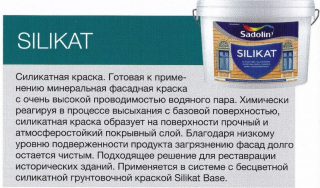With the help of painting, they renew the door, revive the interior and save money so as not to install a new block in the opening. The minimum cosmetic repairs are done independently, the main thing is to choose the right paint. The composition must be durable, easy to use and create a beautiful surface. Paint for interior doors in an apartment differs in technical characteristics, quality and drying speed.
Varieties of paints for interior doors
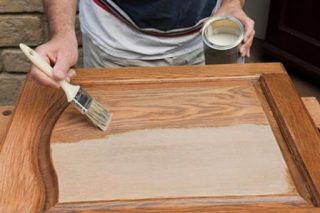
Paints and varnishes decorate the door leaf and protect it from high humidity and decay. The service life of the frame and sash is increased, and the door gets a new beautiful look. If the interior block is in good technical condition, painting the door leaf with your own hands is easily done with the help of various compositions for wood.
Before work, prepare the surface, putty cracks, chips, then clean it with sandpaper. The primer is used to bond the area to be painted with the paint layer.
The enamels form the outer layer that gives the surface:
- shine;
- smoothness;
- color;
- resistance to the action of the environment;
- additional strength;
- chemical resistance.
Varnishes emphasize the texture of wood favorably or form a transparent layer on the surface for additional shine.
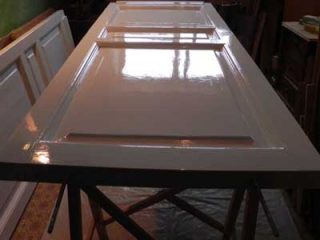
The main types that are used for interior openings:
- water-based paints;
- moisture resistant compounds;
- glazing coatings;
- varnishes.
When choosing, take into account the material of the canvas, the presence of old coatings, the color of the existing paint. Sometimes you need to apply the composition several times to cover and repaint a rich color scheme, especially if you use light colors. Paints and varnishes are applied 2 - 3 times, while each layer is allowed to dry. Sometimes it needs to be additionally sanded before applying the next one.
Water-based
For production, emulsions are used:
- acrylic;
- latex;
- silicate moisture resistant;
- silicate with the inclusion of minerals;
- hydrophobic polyvinyl acetate.
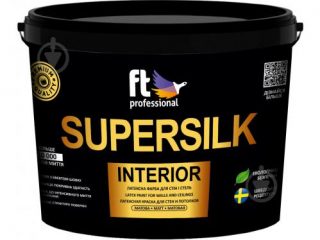
The properties and quality of water-based groups depend on the components in the composition. This paint for wooden doors is evenly applied to different surfaces, except for those doors that have a glossy finish applied earlier. Good for printing stencils for decorative repainting of canvases.
The qualities of water-based paints:
- low resistance to moisture, used for door leaves in living rooms where it is dry;
- easy to pigmentation, therefore, different colors and shades are obtained from the white base;
- protect canvases from ultraviolet radiation;
- have an anti-fungal effect;
- do not crack and do not fade over time, form a resistant film.
Water-dispersion materials dry quickly, do not have a pungent odor, you can paint interior doors made of wood, plastic, MDF, plywood, chipboard.Aqueous polymer emulsions are demanding in terms of transportation and storage.
Moisture resistant

For repainting the doors in the house, colorful materials are used that form a protective film against surface moisture. These water-based compositions are used for bathroom linens, saunas, and kitchens. The resulting coating is vapor permeable. A matte, even layer hides small defects.
Polyacrylates (butyl, ethyl and methyl acrylates), resins and copolymers are added to the paint to obtain a strong film. Antiseptic modifiers prevent acrylic paint discoloration in high humidity conditions. The color of the white base is imparted using dyes for the water-dispersion group.
Properties of acrylic moisture resistant paint:
- good adhesion to the door surface;
- continuous coverage (high hiding power);
- environmentally friendly product;
- beautiful appearance;
- economical consumption;
- long period of operation.
Acrylic compounds are diluted with water, but after the film hardens, they become moisture resistant. The surface is also difficult to abrade. Door paint is quick-drying, almost odorless. Such surfaces do not fade from the action of ultraviolet rays. The disadvantages include considerable cost compared to ordinary water-based paint.
Before use, the acrylic compounds are well mixed, the base is prepared. Fresh wood is impregnated with soil to fix the surface. The first layer is applied with diluted paint, the second is applied without dilution.
Glazing
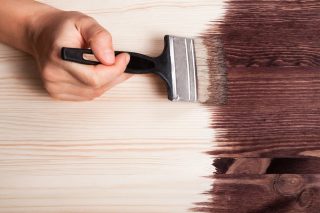
Compounds are often used to paint a door made of wood that has not previously been covered with paints and varnishes. The mixture includes modified and alkyd resins, oils. Glazing retains the initial appearance of the fiber pattern for a long time and increases the product's service life. Use colorful materials to give a natural shine, darken the natural color and reduce surface relief.
Glazing compositions have an effect:
- protect from the negative effects of the surrounding space;
- protect from UV rays;
- prevent the development of fungus and mold on the surface;
- decorating the plane.
Paints do not react to temperature fluctuations, high humidity. For balcony doors, such quality as frost resistance is important. Glazing has transparency, the background shines through it, therefore, before applying, the result is checked in a small area. Drying time from 12 to 24 hours depending on temperature and humidity.
They take products for interior work to paint interior doors. Paints include harmless components without a pungent odor. External products contain synthetic substances, so they are not used inside the house.
Glazing is distinguished by the method of staining, which results in a rich surface color with smooth transitions. Use a different palette of dyes, apply several layers. Before applying the second and other layers, wait until the previous one is completely dry.
Lucky
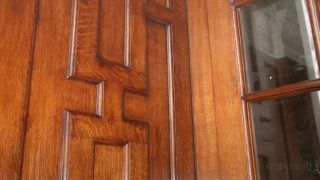
Compositions are produced on the basis of resins, they can be synthetic or natural. Mastics are thinned with solvents, for example, acetone, ethanol, hydrocarbons, essential oils, water. Semi-liquid formulations, when dry, form a transparent film that resists abrasion, moisture, ultraviolet radiation.
The varnishes on the surface of the web harden with the evaporation of a soluble substance or during an oxidation polymerization reaction.
Depending on the method of film formation, they are divided into types:
- thermosetting;
- thermoplastic.
There are solvent-free varnishes on the market, they are viscous due to oligomers, which harden when catalysts or hardeners are added.
Use glossy, matte and colored compounds. Under the varnish, the wood grain or the background of the painted canvas is visible, therefore the door is varnished, which has no defects on the surface.
Varnishing is accompanied by a pungent odor that lasts a long time in the room.
Modern colored lacquers retain the original structure of the wood and give it an original shade. For painted surfaces, color compositions are not used, since the original color will change unnaturally. Varnishes have a lot of colors, there are pastel colors, others are distinguished by a sharp and contrasting shade. Such products are more suitable for natural wood, but they can also paint chipboard, MDF, board doors.
Paint selection rules
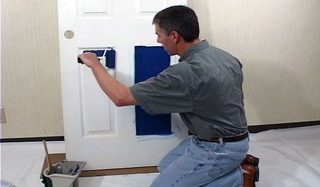
The choice depends on the desired result, painting conditions. Internal doors are processed within the living space, therefore, an odorless finishing product is used so as not to cause allergies or health problems.
There are several such types of paints on the construction market:
- oil;
- water-dispersive;
- latex;
- acrylic;
- alkyd.
Oily oils contain oils that do not give a strong odor. Paints are pigments based on drying oil, which plays the role of a solvent. Oily paint formulations are colored or colorless. For new wooden doors, the second variety is used, and the previously finished ones are repainted with tinted compounds.
In water-dispersion products, water is used as a solvent, so there is almost no smell from them. Harmless products are used in children's rooms and bedrooms; in the process of application, they do not harm human skin if they get into it.
Latex enamels do not belong to toxic products, they do not have an unpleasant odor. The paint dries quickly, after 20 minutes a film appears, and full hardening occurs after 1 hour of waiting. The binder is styrene-butadiene (synthetic resin).
Acrylic products do not smell as there are no toxins in the mixture. Acrylic-based paints are safe for people during the painting process and after drying during use. Alkyd compounds are not all odorless, but there are options. There are glossy, matte, semi-matt enamels, the use of which is recommended in rooms where people with allergies live.
Required tools and materials
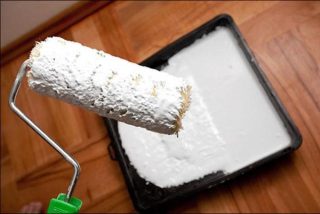
To clean the surface of the door frame and door leaf, use a construction hair dryer, a sander, or manually remove a layer of old paint using emery skins. The surface is painted with a roller, brush or spray. For primer and paint, separate brushes or roller attachments are required. You can wash the used ones with solvent, but it is better to take new ones.
The roller is used on the flat surfaces of the sash and on the long planes of the door frame. Hard-to-reach places are painted with brushes. The sprayer can be used if you have experience with it. For its use, the surrounding space is covered with old newspapers or polyethylene.
To lay the canvas in the working position, use an old table or special goats - two stands made of wood or reinforcement.
Other tools:
- hammer, screwdriver, pliers;
- pallets for diluting paint, varnish, soil;
- masking tape;
- spatula, emery grinding machine, rags.
You will need a putty for wood, it is usually ready for use and packaged in small containers of 200 - 250 gr. The soil is taken concentrated, it is diluted in accordance with the instructions on the package. The paint is purchased in accordance with the purpose.
Emery paper is taken No. 60 for large irregularities and No. 120 - 240 for cleaning the putty surface.
Preparatory work
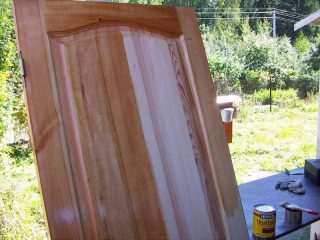
A new wooden door is treated with antiseptic compounds, primed.On the previously painted sash, paint is removed if it peels off and does not hold well. An even and solid coating is not touched, only sanded with sandpaper and painted in another selected color. Natural wood is sanded to a perfect surface.
To make it convenient to work, perform the following actions:
- the canvas is removed from the hinges, sometimes you just need to lift the flap and remove it from the loop pin, in another case, unscrew the screws on the loop;
- remove the lock, handle, decorative overlays for the key cavity.
It is best to remove the old layer with a construction hairdryer. You need to help with a spatula and emery. After warming up with a spatula, pry off the paint film and remove. The remaining particles are cleaned with sandpaper. It is necessary to work carefully so as not to damage the door area.
You can use paint stripper. The solution penetrates deep into the film and makes it soft, after which it can be easily removed with a spatula. The chemical method works faster, but the product is toxic, you need to use a respirator. With the use of the product, the risk of damaging the area is reduced, the solution is inexpensive.
The putty completes the preparatory stage. The canvas is leveled over the entire area or only cracks are repaired. After the putty has dried, the layer is smoothed with emery to a perfect surface.
Features of painting interior doors with your own hands
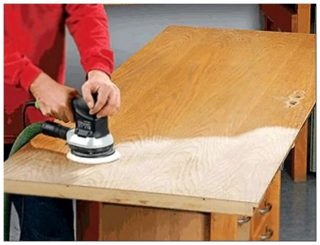
When using a brush, paint in one direction to hide the lint marks as much as possible. This method is almost never used due to the sloppy end result. The roller is used more often, because it rolls out the paint evenly, leaves no traces. For paints based on acetone, white spirit and solvent, you must not take the foam padding, since the surface will become unusable after several rolls.
There is an option to use a spray gun if the house has several doors for painting. It is unprofitable to rent expensive equipment for the sake of one unit.
If the canvas is covered with veneer, it is better not to destroy its integrity during preparation. A soft rag or brush is used for cleaning, and hard-to-reach areas are treated with fine emery. Dust is removed with a brush.
Before painting, clean the floor in the room with a vacuum cleaner or thoroughly sweep it with a broom, then wipe it with a wet rag so that no dust particles settle on the painted surface.

